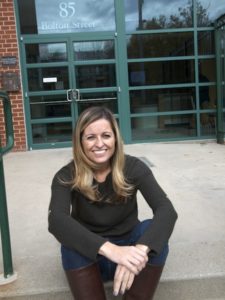Background: Molecular biologist Elisabet de los Pinos was just 37 when she had the novel idea to use viral proteins to deliver cancer-killing drugs directly to tumor cells—to enhance the efficacy and reduce the toxic side effects of traditional chemotherapies. To sound out her theory, she turned to the world’s top virologists, who encouraged her to develop the technology.
She raised $4 million from angel investors to get Aura Biosciences up and running, and carved out a spot in Boston’s booming biotech hub. But to actually set up her lab, she turned to someone perhaps unexpected—a postdoc.
AAAS MemberCentral Writer Selby Frame: Tell me a bit about the evolution of your idea.
Elisabet de los Pinos: I felt that we (the medical industry) had an arsenal of really good cancer drugs and if we could deliver them better we would have more effective treatments for patients. Using viral proteins was something novel. We knew that some viruses were associated with tumors and that some actually created tumors—so the association between virus and tumors had always been there, but no one had approached it to create a first in class targeted cancer therapy.
I had no technology when I started incubating the idea, so I started with a few viruses and selected several groups that were working on new technologies—in Germany, the UK, France and the U.S. That was very exploratory work to see whether this idea would make sense and could actually be a drug, because there are many things that are great scientific ideas but when you try to make them reproducible, or scale them to a bigger experiment, you can’t.
Ultimately we had to choose one virus to work with as a startup. We screened with different academics and found that John Schiller’s work with papilloma viruses and viral prophylactic vaccines at the U.S. National Cancer Institute was the most reliable and had the best data. John had been the first to develop a cancer vaccine, so he knew what to do, how to bring a product from the bench to the bedside.
SF: Where did you go for startup funds and how are you continuing to attract investors?
It takes an entrepreneurial skill to engage people in your idea. I was a first-time CEO, with three and a half years in big pharma—not a 30-year career—trying to launch my company.
I leveraged a network that I had built through my career and as a student to pull together a syndicate of private investors; a network that spanned through my professors, colleagues and mentors, and people I met through my time at the MIT Entrepreneurship program and during the MIT business plan competition.
It’s never too early in your career or as a student to start thinking about building your network and continuously expanding it. One day those contacts may be useful for fundraising as either investors or as a means to a warm introduction to an investor, which is much more effective than cold-calling investors. Become part of entrepreneurial and professional organizations early on to expand your network, participate in business plan competitions and seek the right mentor.
SF: Is it true that you worked primarily with a postdoc to put your company together?
EP: Yes! The key person who was most important was one of the postdocs in John Schiller’s lab, Dr. Rhonda Kines, who actually moved to Boston to help me build our lab.
She was amazing because she was one of the few people with the know-how of the technology and a top scientific background. I had her with me so I could focus on the business and she could do the science. She helped me establish the lab, get the contracts. She trained the first scientist.
To run a company you need a mix of people with different expertise and with entrepreneurial skills—who are not afraid, who are not going to go to a corporate job right away after their Ph.D. This was great science that was developed in my lab, so I think she said, “I’m going to jump to this startup and see what will happen.” The experience she got was excellent. She was part of the executive discussions because we were just a very small company. She was leading a lab—that’s the beauty of startups. As things evolved, the company grew and we got a head of research with a lot of experience in drug development.
And once we fully incorporated and the company was moving along, she decided to go back to NIH to keep working, to use their infrastructure to further develop the technology. Now, with that experience, she is so important to us. She is the scientific liaison between a pure academic lab and the development startup.
SF: Do you think startups are a good option for recent grads who want industry experience?
EP: There are many ways someone with a Ph.D. or postdoc can transition from academia to industry and the startup ecosystem is fantastic for that. This type of profile of the scientist who moves from a pure academic career to an early-stage business or startup is something that should happen more and more. And, you know, big pharma loves these profiles, because they have the entrepreneurial drive and the ability to solve problems.
SF: On the downside, well over 50 percent of startups fail. Is it wise to cut your teeth on a job you might only have for a couple of years?
EP: That’s true. But regardless, I think the experience they have–even if it fails–it’s much, much better than just being a part of a well-established organization that trains you in a very specific part of a big process. You have very little creativity or involvement in the big picture. They may be just a piece of the puzzle, instead of thinking of how to solve the puzzle. I would encourage many more scientists to create more of these ecosystems, back and forth, where there is not a fixed career but there’s movement between one and the other. It keeps you better skilled for the future.
SF: When you interview someone, what makes you say this is someone I want to hire?
EP: I always ask this one question when I recruit: Do you think you’re lucky? And if they say, “normal,” then I don’t recruit them. But if they say, “I’m so lucky, because …,” I hire them. Because lucky people are usually happy people who can help solve problems. They are self-confident and at the same time humble. The best thing is to have someone with a variety of skills—not a single one—then they have the possibility to move or evolve in their roles as the company grows. I’m not so much concerned whether the degree is from Harvard or Northeastern, because we have such smart brains everywhere. I think it’s more of an attitude toward solving problems, having flexibility and a good optimism.
SF: You’ve said that you don’t have to run a company like a male CEO. How do you run yours in a way that you think is distinctively your own?
EP: For me, I hate hierarchy—I don’t impose roles but I ask everyone to give the best. I obviously have to put timelines and sometimes apply pressure, but it’s more of a teambuilding effort. I am a first-time CEO and I have hired people who are so much better than me, who have so much more experience and who come with amazing backgrounds in different companies. So it’s difficult to rule them like you know everything. I have to rely on their experience to contribute to the overall goal of the company.
SF: Nanodrugs are being called “magic bullets” in cancer chemotherapy. Where does your class of nanoparticles fit into the picture of new drug-delivery innovations?
EP: I think that the field is still young but it certainly has a lot of potential and will be an important new class of drugs moving forward. We create pseudovirions, which are synthetic viruses similar in structure and behavior to wild viruses but lacking in viral DNA—just empty protein shells. The most important thing is that it has two components: The delivery alone doesn’t do anything and the drug alone has too many toxicities or does not have enough activity. So when you combine it, you have a strong drug to move forward that is more targeted, has better tolerability and optimal efficacy. You have so many possible combinations: What type of drug and what type of delivery? What type of targeting and what type of tumor?
There are a few other companies that use a delivery based on polymers and they have gone faster into the clinic, but we are the only ones using a (pseudo) viral delivery that we know of. It’s something very novel. Our data are looking extremely positive, so we will hopefully have a first-in-class when we move to the clinic next year. All the data has been generated here and there is a joint publication with NIH coming out soon that we’re excited about. It’s been such an intense collaboration.
SF: What’s your advice for students preparing for careers in biopharma?
EP: Ideally, to be a scientist with broad experience, instead of working in a silo or defined subject for very long. If you want to move to industry, one way to do that is to become a key opinion leader in a particular field. That’s fine. But those who are in a hybrid field, it’s really good to learn from different groups and also get a little bit of business experience. A combination of Ph.D. and M.B.A. is great, of course, but it’s very expensive and very long. Even if it’s not a full M.B.A., to get some business experience in combination with science is great, and that can be done in working.
One thing is to publish papers and the other is to bring drugs to patients. To bring drugs to patients you need as many different capabilities as you can think of. It’s not a bad idea to jump from one to the other. Sometimes we have been negative about “jumpers,” but no, having a broad base of experience when you are young is fantastic.

